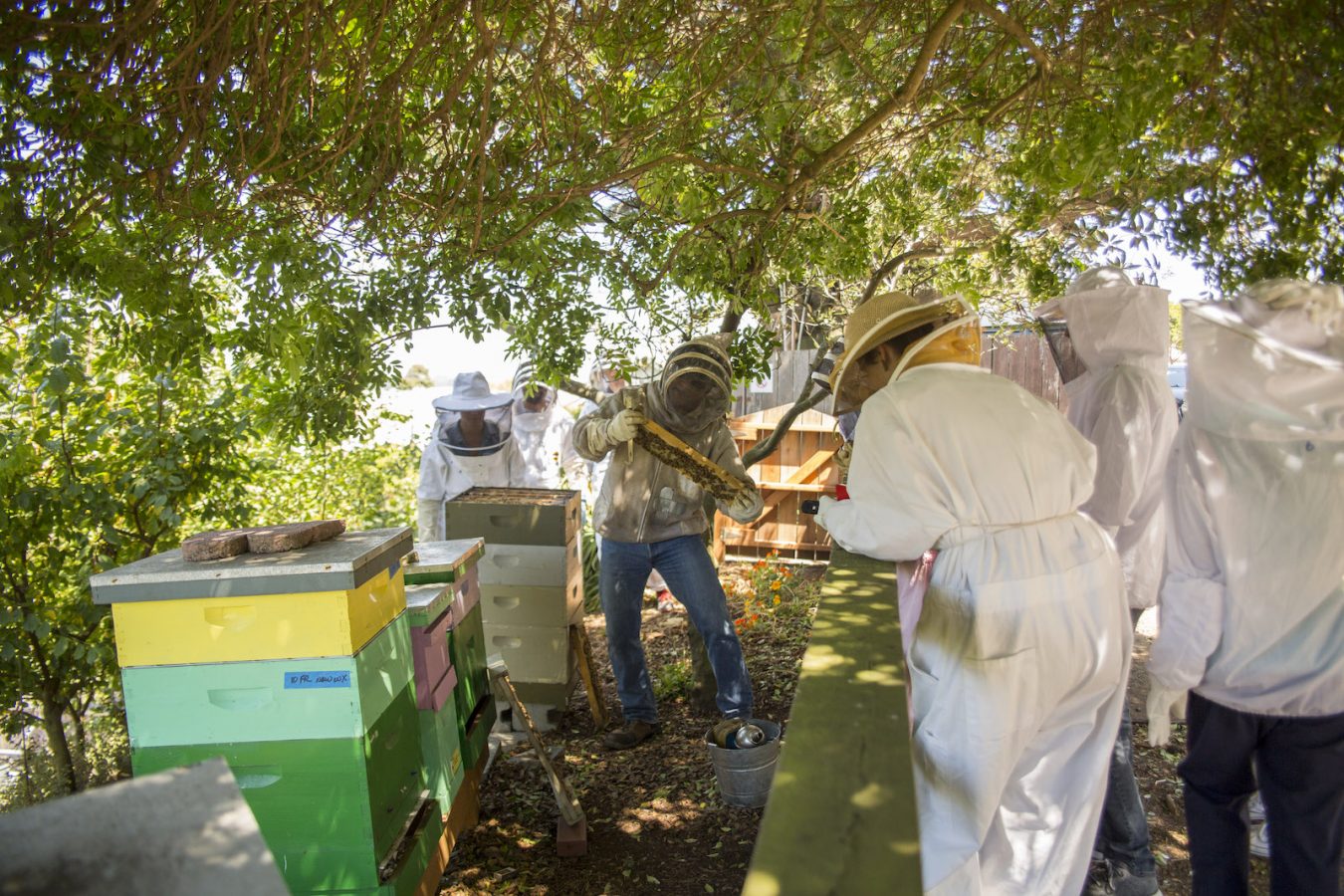Photography: Amina El Kabbany
Words: Jordan Kushins
Want to experience urban beekeeping for yourself? Follow Garden for the Environment on Eventbrite to check out other beekeeping and gardening classes.
It’s a typical summer Saturday in San Francisco — foggy and frigid out west towards the ocean and grey to the north in Golden Gate Park — but this morning the sun is shining brightly on a sloping half-acre haven nestled in the shadow of Mount Sutro. Birds chirp. Warm breezes blow. Leaves rustle. The steady flow of traffic on 7th Avenue is audible but feels a million miles away from where I’m sitting — a small clearing surrounded by African Daisies, Lilies-of-the-Nile, Jerusalem Sage, Mexican Lobelia, and ten total strangers. We’ve all come here, to the idyll that is Garden for the Environment, to learn the basics of urban beekeeping.
Urban beekeeping is very much a thing, and interest in the practice is on the rise. “You’re overseeing a colony: tending to their health, and making sure they have adequate space and resources to thrive,” says Fernando Aguilar, our intrepid instructor. Per the San Francisco Beekeepers Association, the western honeybee pollinates nearly 30% of our produce — “Next time you eat an apple, thank a honeybee!” their brochure cheerily suggests — but their livelihood has, in recent years, faced increasing threats from pesticides, extreme weather conditions brought about by climate change, and Colony Collapse Disorder (CCD), a menace that has been ravaging the bee population since as far back as the 1980s. Classes like these are an opportunity to engage and educate, first and foremost. “In nature, bees make their own hives in hollowed-out enclosures — mostly trees or logs. We use man-made hives that have been built to fool bees into thinking that it’s just like home.”

With his dusty sneakers, well-worn jeans, and faded T-shirt featuring a trio of illustrated Apis mellifera, Aguilar exudes outdoorsman vibes; but he was a bit of a late bloomer when it came to pursuing his passion for the environment. Around 12 years ago, he found himself in a period of personal transition. “When your kids grow up and leave the nest, you’ve got all this free time,” he says. “You start to gravitate towards what you’ve always wanted to do. For me, that was natural sciences.”
The rest of us have gathered here together from around the Bay Area with various motivations and expectations. There’s Kathleen, who took her first organic gardening class at GFE 20 years ago, which later inspired her to start planting on rooftops; she and Teri live in Bernal and volunteer at Alemany Farm, and have been considering starting a hive in their backyard. Sharine was gifted four tickets by her boyfriend, and brought along a few friends who had previously accompanied her to an urban beekeeping dinner event at 18 Reasons in the Mission. In 2012, Raphael debuted “Bee,” a short film that is both “mystery and love story,” he says, and is centered on a beekeeper; he lives around the corner and has also been thinking about making things official with a hive of his own. Cynlie is a designer looking to try something new. Danny is the garden manager at the College Hill Learning Garden, and Aguilar has been assisting her with some hives she inherited.
Aguilar’s own journey started with gardening, and soon discovered the siren call — ahem, buzz — of bees. After a year of research and regular sessions at the SFBA, he invested in a hive of his own, and soon began teaching beekeeping classes for adults, as well as kids at the Boys & Girls Club, where he’s also a board member. Aguilar now has seven hives, strategically dotted across the city and up in Mendocino county, and advises countless former students and friends who have set up their own.

It’s a heck of a lot of work, and like the vast majority of those who get into beekeeping, Aguilar does it purely for the love of pollinators. “There are some professional beekeepers who truck in thousands of hives for almond pollination, and some we call ‘sideliners’ who may make a little money off of their honey,” he says — but those are the exceptions. “Most of us do it because it’s a rewarding connection to the natural world.” In other words: It’s a hobby, albeit one that requires much more than a casual commitment.
Eventually — no matter how trained and skilled you are — you will get stung.
“Maintaining a hive is a big responsibility,” Aguilar says. “You know — like having a pet.” Except, of course, this pet is a superorganism composed of anywhere from 5,000 bees in the winter to 80,000 in the hyper-productive summer months.
If that sounds super intense and potentially dangerous, that’s because it can be. Eventually — no matter how trained and skilled you are — you will get stung. “They say you’re not really a beekeeper until you get stung,” Aguilar tells us. “It’s definitely going to happen.” He reckons it happens to him about 15 to 20 times a year, and recalls for us a few of his greatest pricks: the time he was driving a van with “a million” bees in the back wearing a ventilated suit but no veil and “got whacked” in the neck, so he had to pull over to the side of the road somewhere in the middle of Chico; the time he realized that bees’ stingers go through jeans; the time he was truly wowed by a singularly potent poke. “I call that one the orthodontic bee,” he says. “You know how when dentists give you a shot and they look for the nerve, they might have to shoot you three or four times to find it? This guy got me right on the first try.” He brings his hands to his chin and mimics his face blowing up like a balloon. We wince and groan as a group, yet he’s largely unbothered. There’s a solid lesson there: cover your face.
To demonstrate, he grabs his “disgusting dirty bee jacket” made of a fine, sturdy mesh that was once white but is now a medley of browns and greys. He zips it up, grabs the hood, brings it over his black-and-white Giants cap, and completely disappears behind the veil. It’s this — or, often, a full suit — plus a nice pair of goatskin gloves that will provide as much body protection as possible.
 (A quick note about bee stings: Severe allergies and anaphylaxis are deadly serious — beekeepers should always keep an EpiPen handy — but they’re less common than the public might perceive. “Local reactions like itching and swelling are normal,” Aguilar says. “That doesn’t mean you’re allergic.” In addition, he hopes to set the record straight on a common issue of mistaken identity. “There’s a misconception that wasps and bees are the same thing. Wasps are carnivores that will ruin your picnic and continue stinging you multiple times. Honey bees are more or less ‘vegetarian,’ so to speak. They won’t attack unless they’re defending themselves or their home.”)
(A quick note about bee stings: Severe allergies and anaphylaxis are deadly serious — beekeepers should always keep an EpiPen handy — but they’re less common than the public might perceive. “Local reactions like itching and swelling are normal,” Aguilar says. “That doesn’t mean you’re allergic.” In addition, he hopes to set the record straight on a common issue of mistaken identity. “There’s a misconception that wasps and bees are the same thing. Wasps are carnivores that will ruin your picnic and continue stinging you multiple times. Honey bees are more or less ‘vegetarian,’ so to speak. They won’t attack unless they’re defending themselves or their home.”)Having the right gear is a non-negotiable part of being a beekeeper. The hive itself — which, depending on the design, looks like a stack of boxes, or a kind of modified filing cabinet — is filled with rows of vertical frames. “The frame is everything,” Aguilar says. “It’s where the bees secrete wax and where they build their honeycomb. It’s the nursery where they put their babies, it’s where they put their food.”

An unfortunate reality of modern beekeeping is the necessity of miticide. After harvesting honey, Aguilar recommends treating the hive to wipe out mites, which he says are the commonly accepted root cause of CCD. As its gotten more coverage in the past decade or so, responsible procedures like this have become an “ethical” concern. “Treating hives with integrated pest management (IPM) is just a fact of life now,” he says.
As one might expect, hives are incredibly busy hubs with a lot of constant activity. The flight path must always be kept clear, and wits must always be kept in check: no sharp, sudden movements, no clanging and banging, no shouting. “You gotta be calm and deliberate,” Aguilar says.

Before we put our new knowledge to the test, it’s time to fuel up. Aguilar brought three glass jars filled with a trio of different honey samples for us to try; each is a completely different hue, from light, bright gold to deep, molasses-y brown. We nab toothpicks, dip them in, and taste, and it’s remarkable how the flavors vary from one to the next — they’re all sweet, but in completely different ways. “Connoisseurs often prefer the darker colors,” he says. “But it’s like wine. Go for whatever you like.” Another bonus: Honey will last indefinitely, so long as it’s the real deal. “Some people think that crystallization means that it’s gone bad,” he says. “A lot of stuff being sold out there is half sugar syrup. Crystallization is actually a sign of pure honey.”
It’s been a little over an hour of learning. Now we’re ready. It’s time to meet some bees.
There’s a palpable sense of excitement when everyone starts suiting up, as we become what looks like a crew on our way to deal with an alien invasion or dramatic hazmat situation. Except we’re all smiling.
We make our way on a plant-lined dirt path up a small hill to get to the hives, which here are painted in a cheery mix-n-match of yellows, greens, and purples. We gather around, arranging ourselves so everyone has a good view.
It’s been a little over an hour of learning. Now we’re ready. It’s time to meet some bees.

Aguilar uses a smoker to mollify the bees: It’s a spouted metal can with an accordion-like bellows attached, and slightly resembles a friendly, old-timey robot. When he gets it going with repeated pumps, the smell of a cozy campfire wafts through the open air. “We don’t know 100% why it works,” he says. “But bees communicate with pheromones, and smoke masks those. It also makes them think there’s a forest fire. They’ll start digging into the honey to get as much food as possible before they take off to get away.”
Whatever’s going on, it sends them all into a group stupor; when he slowly pulls out a frame, the bees are deeply chill. A few flit away. A few lazily drop to the ground. “Are they drunk?” someone asks. “They might have just been born, and haven’t developed their wing muscles yet,” Aguilar says. “Should we pick them up?” someone else wonders aloud. “They’ll make their way back,” he says.

Maybe the fresh knowledge has allayed any fears and made us brave (or maybe the smoke has somehow soothed us too), but all of us humans are also deeply chill. I thought I might be nervous, but I feel more excitement and curiosity than anything else. Aguilar hands the frame around so whomever is interested can hold it themselves. “It smells sweet!” someone says. There’s a general sense of awe that’s settled over us, coupled with the kind of camaraderie that comes when you’re in a somewhat weird situation with strangers.
When the frame is passed to me, I take it carefully and realize that IRL bees are not something I’ve ever really looked at up close, and especially not en masse. My general response if one lands on me in the wild is to freeze and look away (maybe if I avoid eye contact they’ll leave me alone) or to flail like a madwoman (maybe they’ll be more scared of me than I am of them). But here, now, after gaining a new understanding of them? They’re lovely, and more than a little magic. It feels pretty special to be entrusted to handle them, if only for a minute.

Aguilar sees this as a kind of make or break moment. “You can read books and hear talks and watch videos,” he says. “But until you open up a hive, pull out a frame, and feel the energy and vibrations of 500 to 1,000 bees at once, you won’t really know if beekeeping is for you.” And every one of us emerged sting-free.
It was a unique experience made all the more special because of the particularly pleasant setting. Garden for the Environment was established in 1990, and director Maggie Marks calls it “San Francisco’s teaching garden.” In its 29-year history, the space has offered classes, workshops, volunteer opportunities, and intensive sessions aimed at helping beginners get their hands dirty. “Our mission is to make this an educational place for everyone,” she says.
In addition to slightly more sporadic — or seasonal — programming like beekeeping, bouquet making, urban chickens, rainwater harvesting, and summer fruit tree pruning (which I passed by on my way in this morning), there are monthly core courses like composting, edible gardening, and how to establish your own sustainable garden. All of these are designed to be satisfying one-offs, but, taken together, form a comprehensive approach to gardening that is both inspiring and galvanizing.
Even those with enough of a passing interest in being surrounded by well-tended greenery are welcome to come hang out at GFE, which is free and open to the public. “We have fantastic instructors, but we like to say the garden is our best teacher,” Marks says. “You’ll see how things grow; you’ll see animals and insects and birds. There are no gates on the garden; it’s here to be a refuge in whatever way people choose. It would be tough to come here and not learn something; there’s always something happening around you.”





